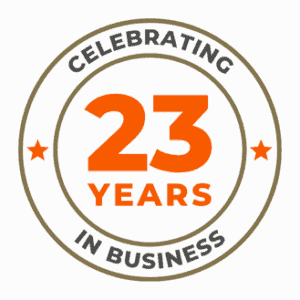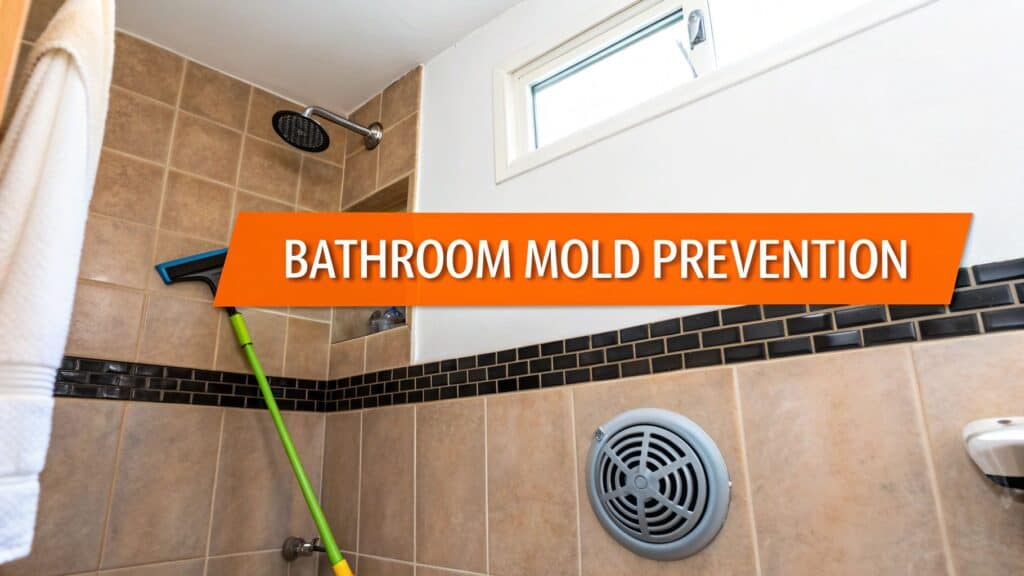For discerning homeowners in Orange County, effective mold prevention in bathroom environments is more than a cleaning chore—it’s a critical strategy for protecting your family’s health and the value of your property. A proactive plan is your strongest defense against moisture, which can quickly escalate into costly structural damage and significant indoor air quality issues. At Sparkle Restoration Services, we believe in empowering our clients with the knowledge to turn chaos into calm, fast.
Why Proactive Bathroom Mold Prevention is Essential
Even in meticulously maintained homes across Newport Beach and Irvine, hidden moisture presents a persistent threat. Bathrooms are naturally high-humidity zones, creating the ideal conditions for mold to thrive. The steam from a hot shower, a minor faucet drip, or condensation on windows provides all the moisture mold spores need to colonize common surfaces like grout, drywall, and wood.
Ignoring the early signs of moisture problems can lead to consequences that extend far beyond cosmetic issues. Unchecked mold growth can:
- Degrade Your Indoor Air Quality: Mold releases spores into the air, which can trigger or worsen allergies, asthma, and other respiratory conditions, posing a health risk to your family.
- Cause Significant Structural Damage: Persistent moisture weakens drywall, promotes wood rot in structural framing, and can compromise the integrity of your home over time.
- Diminish Your Property Value: Visible mold or a history of water damage is a major deterrent for potential buyers, significantly impacting your home’s market value and appeal.
- Lead to Costly Remediation: What begins as a small leak can rapidly escalate into an extensive remediation and remodeling project, resulting in substantial, often unexpected, expenses.
A cornerstone of protecting your home is understanding the importance of regular property maintenance. It’s about shifting from a reactive mindset to a preventive one, stopping potential disasters before they start.
At Sparkle Restoration, our philosophy is rooted in decades of experience: an ounce of prevention is worth a pound of cure. As an IICRC Master Certified firm, a Licensed General Contractor, and a BBB Torch Award Winner for Ethics, we’ve seen firsthand how small, consistent actions prevent major catastrophes.
This guide provides the actionable, professional-grade strategies we implement for mold prevention in bathroom settings daily. It is a playbook built from our extensive experience in Orange County, designed to help you create a healthier, more resilient home. For a deeper analysis, explore our article on the truth about mold contamination, health risks, and prevention tips.
By mastering moisture and ventilation control, you can transform your bathroom from a potential liability into a safe, beautiful, and healthy space.
The Science Behind Mold Growth in Bathrooms
To effectively combat bathroom mold, it’s crucial to understand your adversary. Mold growth isn’t a random occurrence; it follows a predictable scientific formula. By understanding the components it needs to survive, you can ensure your bathroom never provides them.

The Mold Triangle Unpacked
For mold to establish itself, it requires three key elements, often referred to as the “mold triangle.” The advantage for homeowners is that by removing just one of these elements, you can halt mold growth completely.
- A Consistent Moisture Source: This is the most critical factor and the one you have the most control over. In a bathroom, moisture sources are abundant: condensation from showers, leaks under the sink, or even damp towels left on the floor.
- An Organic Food Source: Mold requires organic material to feed on. Bathrooms often provide a veritable feast, including the paper on drywall, wood studs within walls, soap scum, and everyday dust.
- A Suitable Temperature: Mold thrives in temperatures between 60 and 80 degrees Fahrenheit—the same range most Southern California homes are kept in year-round. This makes temperature the most difficult part of the triangle to control.
By focusing your efforts on what you can control—moisture and food sources—you effectively break the triangle. You create an environment inhospitable to mold, which is the foundation of a healthy, mold-free home.
How This Plays Out in Orange County Homes
Let’s translate this science into a real-world scenario. At Sparkle Restoration, we’ve remediated this exact situation in high-end properties across Orange County, from Newport Beach to Irvine.
A classic example is a slow, nearly invisible drip from a P-trap beneath a bathroom sink. Over weeks, this minor leak saturates the wood cabinet and the drywall behind it. This dark, damp, and undisturbed space becomes a perfect incubator for a significant mold colony.
Another common culprit is shower steam. If an exhaust fan is inadequate or not used properly, steam settles on walls and ceilings. This lingering dampness is often sufficient for mold to begin feeding on paint or drywall, leading to the familiar black specks in corners.
Identifying Common Bathroom Molds
While thousands of mold species exist, only a few are common in bathrooms. Identifying them can be useful, but our expert advice is to treat any visible mold as a potential threat that requires immediate attention. To help you separate fact from fiction, we created a guide on the facts and myths about mold and mold remediation.
The species we encounter most frequently include:
- Penicillium/Aspergillus: These common indoor molds often appear as blue or green patches and can grow on nearly any damp organic surface.
- Stachybotrys Chartarum (Black Mold): This infamous mold is slimy, dark greenish-black, and requires constant, significant moisture to grow. We typically find it after a serious water leak or flooding event. It is a major health concern due to the mycotoxins it can produce.
The reality is, mold in bathrooms is exceedingly common. One study found that only 13% of tested bathrooms were completely free of mold. The same research identified potentially toxic species like Stachybotrys in 16% of bathrooms, while the common Penicillium and Aspergillus groups were present in a staggering 59% of cases. You can review these findings on the National Center for Biotechnology Information website.
Understanding the science behind mold empowers you. The next time you see lingering steam, spot discoloration under a sink, or detect a musty odor, you’ll recognize it not just as a cleaning issue, but as an open invitation for mold—one you must decline swiftly.
Mastering Moisture Control to Prevent Mold
Moisture is the lifeblood of mold. Without it, spores cannot grow. This makes mastering moisture control the single most effective strategy you can use to prevent mold in your bathroom. It’s a hands-on approach that combines consistent daily habits with smart, long-term maintenance, turning your bathroom into an inhospitable place for mold.
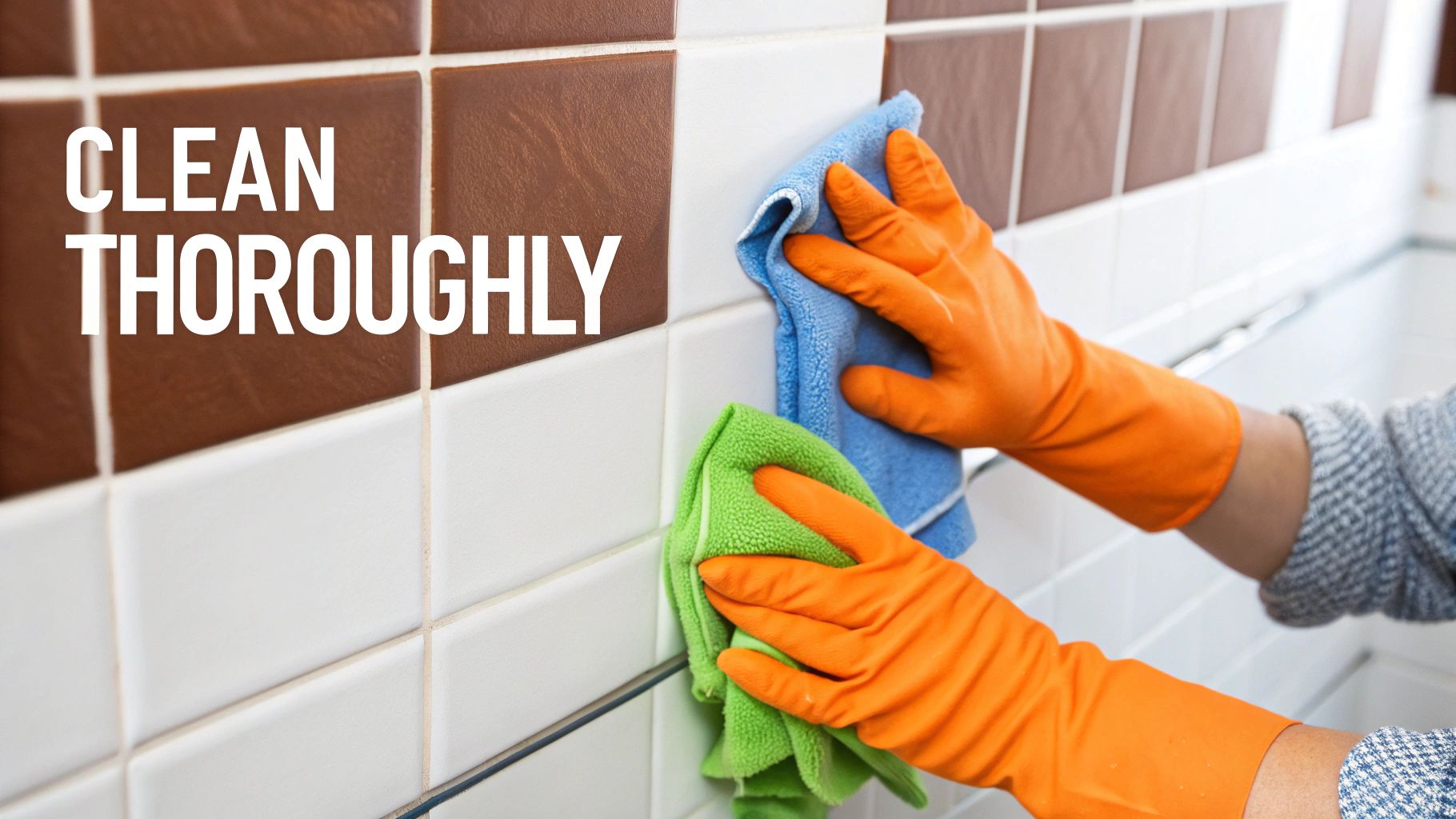
This process doesn’t need to be complicated. By layering small, impactful actions, you create a powerful defense. Let’s break down the practical steps our IICRC-certified experts recommend to homeowners throughout Orange County.
The Power of Daily Habits
The fight against bathroom moisture is won day by day. Simple routines, when done consistently, stop standing water and lingering humidity from giving mold a foothold. Think of these as your non-negotiable daily tasks for a healthy, mold-free home.
Just a few key actions can make a huge difference:
- Squeegee After Every Shower: Keep a squeegee in your shower and make it a habit to wipe down glass doors and tile walls immediately after use. This five-second task removes up to 75% of the moisture that would otherwise evaporate into the air or seep into grout lines.
- Dry Towels and Bathmats Properly: A damp towel bunched on the floor or a perpetually soaked bathmat is a welcome mat for mold. Always hang towels and mats so they can dry completely between uses, preferably on a rack that allows for ample air circulation.
- Wipe Down Spills and Splashes: Don’t let puddles linger around the sink or at the base of the toilet. A quick wipe-down with a cloth prevents water from sitting on surfaces and eventually finding its way into tiny cracks.
These habits might seem minor, but their cumulative effect is massive. They are your frontline defense, actively cutting off the fuel for mold growth before it even has a chance to start.
Sealing Your Defenses Against Leaks
While daily habits manage surface moisture, a more robust defense involves sealing up potential entry points for water. Grout and caulk are the unsung heroes of a dry bathroom, but they need regular check-ups to do their job right.
From our experience in homes across Newport Beach and Irvine, failing grout and caulk are among the top causes of hidden water damage. A tiny crack is all it takes for water to get behind tiles, saturating the drywall and creating a perfect, hidden breeding ground for mold.
To prevent this nightmare scenario, you need to inspect these seals regularly. Look for any cracking, peeling, or shrinking in the caulk lines around your tub, shower, and sink. Do the same for your grout—check for any dark spots, crumbling sections, or gaps.
When it’s time for a replacement, choose your materials wisely. We always recommend 100% silicone caulk over acrylic or latex-based options for bathrooms. Silicone is waterproof, highly flexible, and far more resistant to mold and mildew, making it a superior long-term investment. To see how quickly these small issues can become big problems, you should explore our guide that explains the fundamentals of water damage.
Proactive Plumbing and Leak Detection
Even the most careful homeowner can fall victim to a hidden plumbing leak. That slow drip inside a wall or under a vanity can go unnoticed for months, causing serious damage and feeding a major mold problem. This is where getting proactive with inspections is key.
At least twice a year, do a thorough check of all your bathroom plumbing:
- Under the Sink: Grab a flashlight and inspect the P-trap and both the hot and cold water supply lines. Look for any signs of corrosion, moisture, or active drips. For a surefire test, place a dry paper towel underneath and check it again in an hour.
- Around the Toilet: Check the base of the toilet for any water pooling. Also, inspect the supply line and shut-off valve for any slow leaks.
- Shower and Tub Fixtures: Pay close attention to the escutcheon plates—those trim plates behind the handles and showerhead. If they aren’t sealed tightly against the wall, water can easily sneak behind them.
For an extra layer of protection, think about installing a smart water leakage detector to catch hidden leaks before they do real damage. These gadgets send an alert straight to your phone at the first sign of moisture, stopping a small issue from becoming a catastrophe.
By staying ahead of potential leaks, you aren’t just preventing mold; you’re protecting the structural integrity and value of your property.
Improving Bathroom Ventilation to Stop Mold
Proper ventilation is the unsung hero when it comes to preventing mold in your bathroom. While wiping down the shower door handles the water you can see, a good ventilation system attacks the invisible enemy: humidity. Just cracking a window after a hot shower rarely does the trick. That dense, moisture-heavy air needs to be actively pulled out, which is why a high-quality mechanical exhaust fan is an absolute must-have for every home in Orange County.
Think about it. Every time you shower, you’re essentially filling a small, sealed room with steam. If that steam has nowhere to go, it settles on every single surface—your walls, ceiling, grout, and fixtures. This creates the perfect damp breeding ground that mold loves. A powerful exhaust fan acts like a vacuum, sucking that humid air out of the room and venting it safely outside where it belongs.
Understanding Your Exhaust Fan
Here’s something a lot of homeowners don’t realize: not all exhaust fans are created equal. Their power is measured in CFM, which stands for Cubic Feet per Minute. This number tells you exactly how much air the fan can move every sixty seconds. Getting the CFM right is critical. A fan that’s too weak for your bathroom will struggle to clear the steam, leaving moisture behind.
The rule of thumb is pretty straightforward: you need at least 1 CFM for every square foot of bathroom floor space.
So, if you have an 8 ft x 10 ft bathroom, that’s 80 square feet. You’ll need a fan with a minimum rating of 80 CFM. For a larger master bathroom, say 12 ft x 12 ft (144 sq ft), you should be looking for a fan rated for at least 144 CFM.
This simple calculation works well for most standard bathrooms. However, for bathrooms over 100 square feet, especially those with features like fully enclosed steam showers or large jetted tubs that generate extra moisture, a more specific calculation might be necessary to ensure you’re moving enough air.
To make it easier to find the right fan for your space, here’s a quick sizing guide.
Bathroom Exhaust Fan Sizing Guide
This table provides a quick reference to help you match your bathroom’s square footage with the minimum recommended CFM rating for your exhaust fan.
| Bathroom Size (Square Feet) | Minimum Recommended CFM Rating |
|---|---|
| Up to 50 sq. ft. | 50 CFM |
| 51 – 80 sq. ft. | 80 CFM |
| 81 – 100 sq. ft. | 110 CFM |
| 101 – 150 sq. ft. | 150 CFM |
| Over 150 sq. ft. | Custom calculation recommended |
Remember, this is the minimum recommendation. It’s often better to go slightly higher in CFM to ensure your fan can handle the job effectively, especially in high-humidity areas.
Best Practices for Fan Usage
Having the right fan installed is the first step, but how you use it is what really makes the difference. One of the most common mistakes I see is homeowners turning the fan off the moment they turn off the water. This leaves a ton of moisture still hanging in the air, which then condenses back onto your cool surfaces.
To truly clear the air, you need to run your exhaust fan during your entire shower and for at least 30 minutes afterward. This gives the fan enough time to completely cycle out all that lingering humid air, leaving your bathroom dramatically drier and far less inviting for mold.
Turning this into a daily habit is probably one of the most effective changes you can make to protect your bathroom.
Advanced Ventilation Strategies for Modern Homes
If you’re planning a bathroom remodel or just want a more hands-off, effective solution, modern tech has some fantastic options. As a Licensed General Contractor, we often integrate these advanced systems into our luxury remodeling projects to give clients total peace of mind.
Here are a few of the best solutions available today:
- Ultra-Quiet Fans: Let’s be honest, nobody wants to use a fan that sounds like a jet engine. Many older models are so loud that people avoid turning them on. Newer fans are engineered to be whisper-quiet (look for the “sone” rating—the lower, the better) without sacrificing an ounce of power.
- Fans with Humidity Sensors: These are a complete game-changer. Often called humidistats, these smart fans automatically detect when the humidity in the room rises to a certain level. They turn themselves on and, more importantly, keep running until the air is dry, then shut off. It takes all the guesswork out of it and ensures your bathroom is ventilated perfectly every single time.
- Integrated HVAC Solutions: Your bathroom fan doesn’t operate in a vacuum. It’s part of your home’s entire air quality system. Making sure your central HVAC system is clean and running efficiently helps promote better air circulation everywhere, including in the bathroom. If you’re curious about a whole-home approach, you can learn more about our professional HVAC system cleaning services.
A properly ventilated bathroom is a healthy bathroom. The graphic below shows how regular ventilation checks fit into a proactive maintenance routine to keep mold at bay.
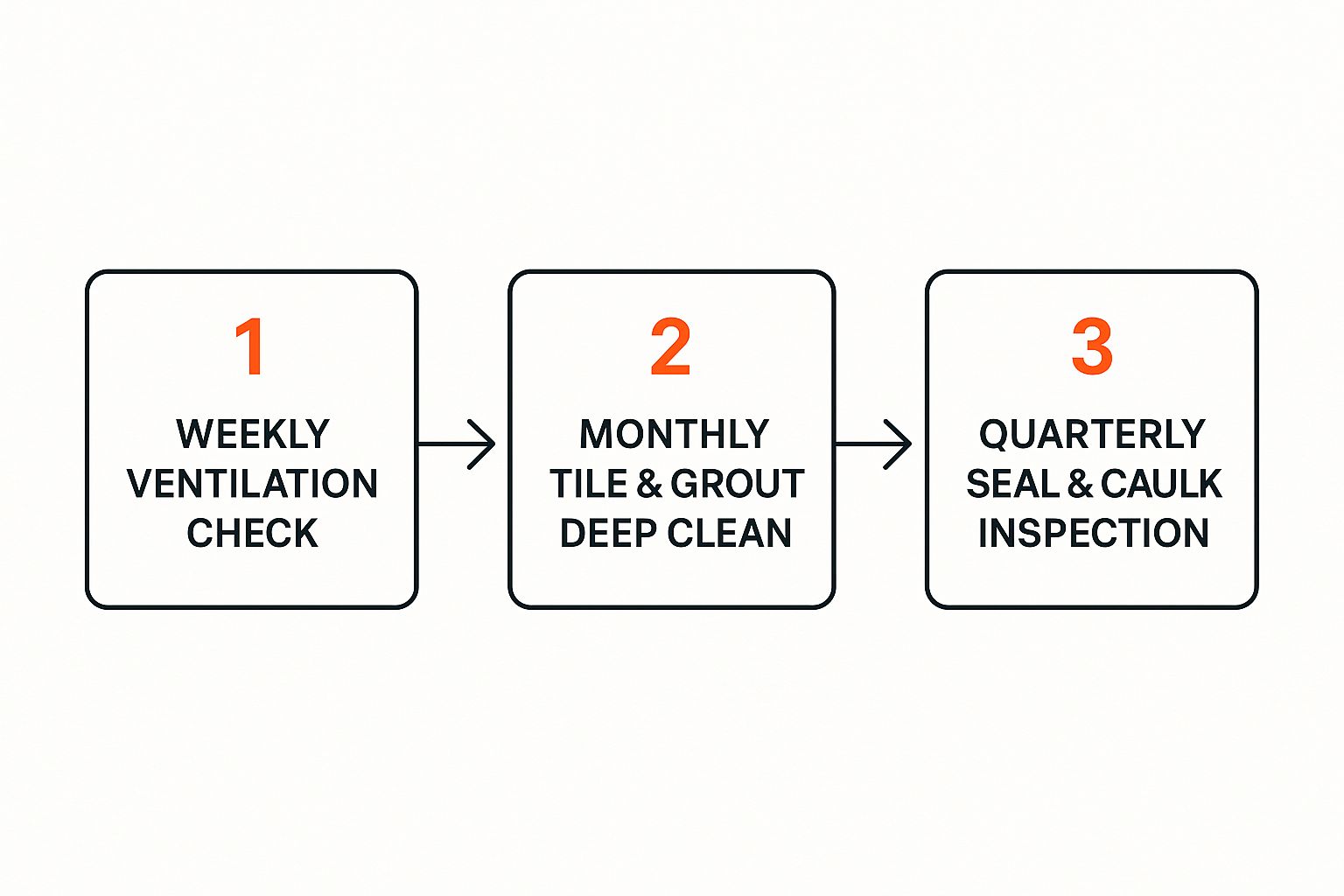
This illustrates how consistent checks of your ventilation, cleaning habits, and grout sealing work together to create a powerful defense. Upgrading your fan isn’t just a minor fix; it’s a strategic investment in protecting your property and ensuring your family is breathing cleaner, healthier air.
Choosing Mold-Resistant Building Materials
If you’re planning a bathroom remodel for your Orange County home, you have a golden opportunity to build a powerful, long-term defense against mold directly into the structure of the room. As a Licensed General Contractor specializing in luxury renovations, we know that smart material selection is one of the most effective strategies for mold prevention in the bathroom. It’s about creating a space that’s not just beautiful, but fundamentally hostile to mold growth.
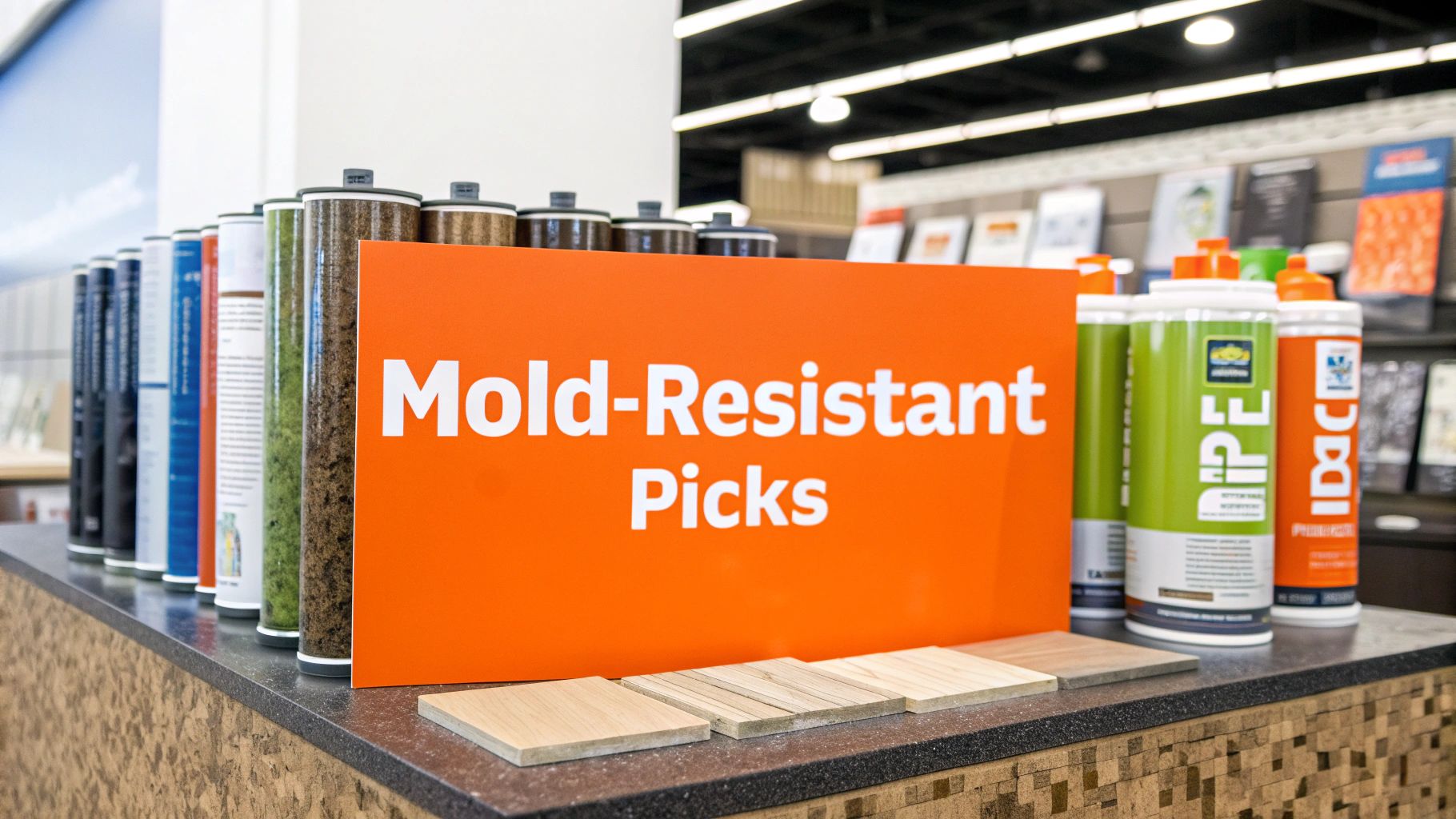
This proactive approach transcends routine maintenance. You’re fortifying your home against moisture intrusion by selecting materials that repel water and eliminate the organic food sources mold needs to survive, contributing to healthier indoor air quality for your family.
Beyond Standard Drywall
Your bathroom walls are the front lines in the fight against mold. Standard drywall, with its porous paper facing, is a gourmet meal for mold spores once it becomes damp. Fortunately, superior alternatives are engineered specifically for high-moisture environments.
The most common upgrade we recommend is mold-resistant drywall, often identified by its green or purple paper facing. This isn’t merely a color choice; the paper is treated to repel water, and the gypsum core is formulated with antimicrobial properties to inhibit mold growth.
- Green Board: This is the traditional moisture-resistant option, offering a solid baseline of protection for damp areas.
- Purple Board: This represents the next level of defense, providing all the benefits of green board with superior moisture, mold, and mildew resistance. It’s an excellent choice for the high-end bathrooms we design and build in Newport Beach and Irvine.
Choosing purple board over standard drywall during a remodel is a small investment that delivers significant long-term protection and peace of mind.
The Superiority of Non-Porous Surfaces
Once your walls are protected, the next step is selecting surfaces that do not absorb or retain water. Porous materials act as a magnet for mold by trapping moisture. The key is to select non-porous or extremely low-porosity materials for your shower, walls, and countertops.
Porcelain and Ceramic Tile are standout choices. Fired at extremely high temperatures, they create a dense, glass-like surface that is nearly impervious to water. Moisture sits on the surface, where it can be easily wiped away or evaporated, rather than seeping into the material itself.
When designing a luxury bathroom, we guide our clients toward materials that merge elegance with performance. Porcelain tile, for instance, offers a vast range of styles while providing a virtually waterproof barrier—an essential component of a healthy, mold-resistant design.
Don’t Overlook Grout and Sealants
Even the highest quality tile is only as strong as the grout that holds it together. Traditional cement-based grout is porous, acting like a sponge that absorbs moisture and stains easily, which in turn provides a food source for mold.
This is where epoxy grout is a true game-changer. Unlike its cement-based counterpart, epoxy grout is non-porous, chemically resistant, and incredibly durable. It never requires sealing and actively repels water, preventing mold and mildew from gaining a foothold. Pairing premium porcelain tile with epoxy grout creates a nearly impenetrable defense system in your shower.
Smart Flooring Choices for Damp Environments
Your bathroom floor endures constant water splashes, steam, and high humidity. Any material that can warp, rot, or trap moisture is unsuitable for this environment.
Here are some of the best mold-resistant flooring options we recommend:
- Luxury Vinyl Tile (LVT): This is one of our top recommendations. LVT is 100% waterproof, exceptionally durable, and available in a wide array of sophisticated designs that can mimic natural stone or wood. It creates a seamless surface that water cannot penetrate.
- Porcelain or Ceramic Tile: Just as they excel on walls, these tiles are a fantastic choice for floors. They are waterproof, easy to clean, and will last for decades.
Avoid materials like solid hardwood, which will warp when exposed to moisture, and most types of laminate flooring unless specifically rated as waterproof. Our integrated design-build process ensures you receive a bathroom that is visually stunning without compromising on the critical need for moisture and mold resistance.
When to Call a Mold Remediation Professional
Knowing the difference between minor surface mildew that you can clean and a significant mold infestation is critical. While diligent cleaning is a key component of mold prevention in bathroom spaces, some situations demand the expertise of certified professionals. Recognizing the red flags early can protect your health, your home, and your finances.
At Sparkle Restoration, we are committed to empowering homeowners. We want you to feel confident handling small issues, but we also believe it’s our responsibility to help you know precisely when to call for professional intervention to ensure your family’s safety.
Clear Signs It’s Time for an Expert
Attempting to address a widespread mold problem without proper training can lead to severe structural damage and health risks. Furthermore, improper DIY methods often cross-contaminate other areas of your home, exacerbating the problem. If you observe any of the following signs in your Orange County home, it’s time to contact a professional.
Here’s what to look for:
- The Mold Covers a Large Area: As a general rule, if a mold patch exceeds 10 square feet (roughly a 3×3 foot area), it is no longer a DIY project. A visible colony of this size almost certainly indicates a larger, hidden problem behind a wall or under the floor.
- A Persistent Musty Odor: If you’ve cleaned thoroughly but a damp, earthy smell lingers, it’s a classic sign of mold thriving in an unseen location—such as a wall cavity, under a cabinet, or within your HVAC system.
- Signs of Hidden Water Damage: Mold and moisture are intrinsically linked. Watch for peeling paint, warped baseboards, discolored spots on ceilings or walls, or bathroom tiles that feel spongy or loose. These are tell-tale signs of a hidden leak feeding a mold problem.
- Recurring Health Symptoms: If family members experience persistent coughing, sneezing, headaches, or allergy-like symptoms that improve when they leave the house, it may be a direct result of poor indoor air quality caused by mold.
Deciding to call a professional isn’t an admission of defeat; it’s a strategic decision to protect your most valuable asset. A certified expert has the training, specialized equipment, and safety protocols to identify the source, contain the contamination, and eliminate it safely and permanently.
The Importance of IICRC Certification
When you need professional help, it is vital to choose a firm with proven, verifiable credentials. This is why selecting an IICRC Master Certified firm like Sparkle Restoration is so important. The Institute of Inspection, Cleaning and Restoration Certification (IICRC) sets the global standard of care for the restoration industry.
An IICRC-certified technician has undergone extensive training in proper mold remediation procedures. They understand the science of mold and adhere to strict protocols for containment, air filtration, and the safe removal of contaminated materials. This is far more than cleaning. Our comprehensive mold remediation services are designed to resolve the underlying cause and restore your home’s air quality to a healthy state.
The industry’s growth underscores the seriousness of this issue. In 2023, the global mold remediation market was valued at approximately USD 1.23 billion and is projected to reach USD 1.52 billion by 2030. This expansion is driven by a greater understanding of the health risks associated with indoor mold. You can learn more about this growing market on Grand View Research.
If you see these warning signs, do not wait. A professional consultation is the safest and most effective step you can take.
At Sparkle Restoration Services, we specialize in turning chaos into calm. If you’re facing a mold problem in Orange County, our IICRC Master Certified and award-winning team is ready to provide expert assistance 24/7. Contact us today for a professional consultation and restore the health and safety of your home. Schedule your free consultation at https://www.sparklerestoration.com.
